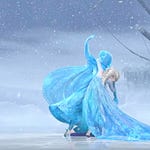I can't believe we're already at the end of the prologue! Two weeks in, and I'm proud of you both for sticking with this. I know it's a lot of time to invest in a project, but it's going to be worth it.
I hope the ideas you came up with has gotten your minds spinning with characters, places, story ideas, and more. And if you're not quite sure yet what you want to tell a story about, that is totally fine.
We have coming up what I like to call Act One, which in storytelling is where we start the story, and as I give a high level overview here on outlines and structure, you'll realize it's where we introduce our characters and the familiar world they start in.
Note: This is going to be a really big lesson, and I recommend you listen to the audio over reading through this because I think it could paint a clearer picture.
But we're going on a journey together.
Over the next four weeks we're going to work on developing the ideas behind what happens in the story.
When my daughter and I would brainstorm ideas that could happen while on our walks, we thought of all of the cool scenes and characters and moments that should make it into a book. And an outline really, really helps make sure the best moments find the right spot in the story to happen.
There are a couple of places I've learned story structure. One of them is called Save The Cat, which started off breaking down story structure for screenwriting, but they've released versions for books as well. The other is called the Snowflake Method.
Let's use both.
We'll go through the different moments from Save The Cat's structure, but use the Snowflake Method.
The Snowflake Method tries to emulate the way a snowflake is formed. You start with something simple, and then you expand from there.
So, for instance, after we identify all of the parts of a story, we're just going to write a single sentence on what happens for that moment or chapter.
Warning: Major spoilers for The Invisible House, but this is the initial single-sentence outline we came up with before we even began the first draft, but it took a lot of brainstorming walks to get here.
And the story changed in some significant ways from here, but being able to explain this story to family at this basic of a level helped us understand if it was interesting or not and if we wanted to rewrite it, it wouldn’t take forever to change the sentences.
Then, after we have single sentences plugged in for every moment, we have a basic story that we could explain to someone from start to finish. It won't have all of the fun details we want to add, but it will help you to look at a story and quickly be able to tell if part of it doesn't make sense, or if there's too much (or not enough) action.
And that way, if you decide something doesn't work, all you're doing is throwing away a sentence and not a paragraph or a thousand words, or days or weeks worth of writing because you built the rest of the story on something you decided didn't make sense after you were off to the races.
There are usually two types of writers:
Plotters (outliners), and pantsers (those who write by the seat of their pants and just keep writing until they're done). The latter are more likely to accidentally paint themselves into a corner and have to rip up a big part of their story and figure out how to fix it.
I don't want that for you, and since you might be new to the idea of structure, and we only have a short amount of time this summer to write, I want to make sure we are as efficient as we can be with your time.
So let’s figure out what goes into an outline:
Blake Snyder came up with his own Beat Sheet of the moments that go into a story, and having that as a reference while I talk you through this in the audio portion of the lesson will be helpful (and so I’m not copying what he had to say over here).
Activity: Once Upon a Time There Was a _______
This is an activity I used to do with my kids for bedtime stories that was very helpful in us both figuring out what went into an interesting story and it was a launching point for a lot of ideas.
Kind of like the ping-pong activity we did, we go back and forth saying:
“Once upon a time there was a ______, named ______, and they lived in a _____. The thing they wanted most in life was ______, but they couldn’t have it, because _____. Then one day…”
And that’s enough to get us through the basics of an Act One structure (more or less).
I recommend you run through 3-5 of these and see if anything strikes up an idea, because in the next lesson…we’re starting our outline!














Share this post